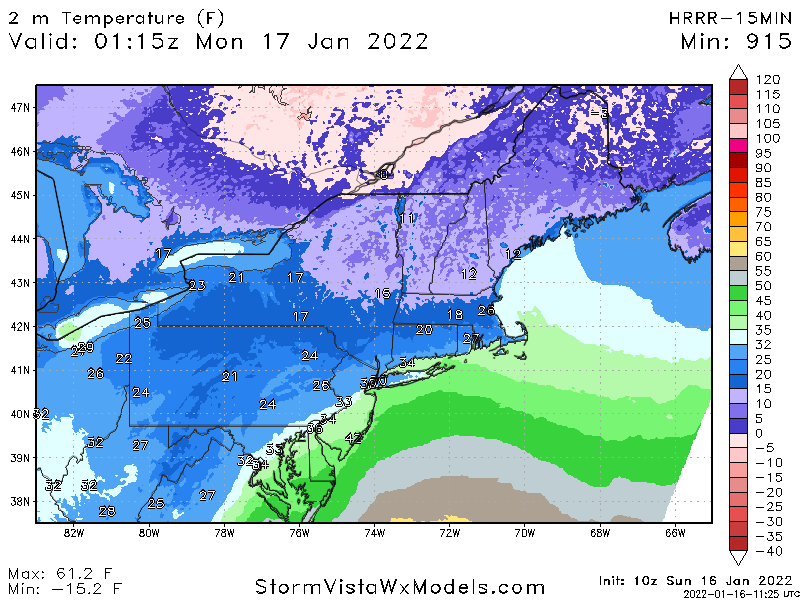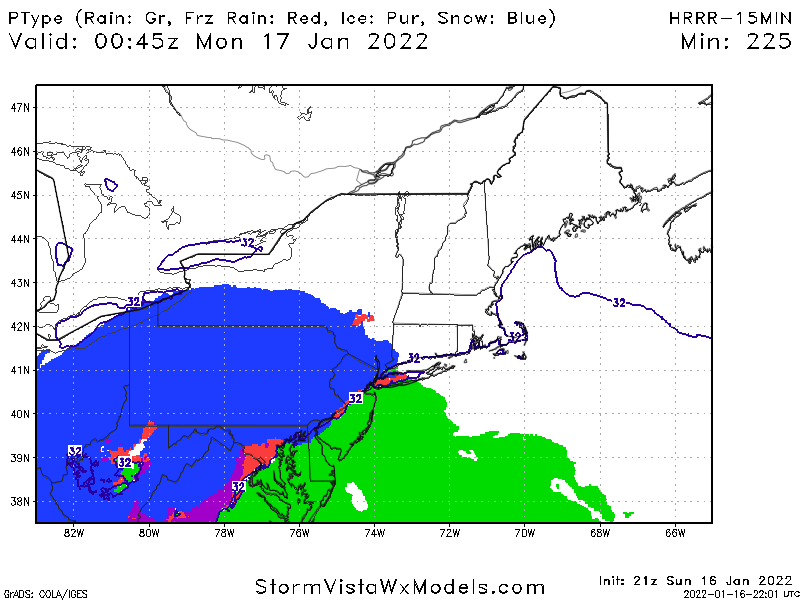-
Posts
776 -
Joined
-
Last visited
Content Type
Profiles
Blogs
Forums
American Weather
Media Demo
Store
Gallery
Everything posted by NittanyWx
-
Depends on which model. Here's what the HRRR had this morning for right now: I'm a big stickler on revisionist history in this field and will call it out every time.
- 460 replies
-
- 1
-

-
For the record, the HRRR has been showing this starting off as snow pretty much all afternoon... Use the clown maps at your own risk. But it's straight up false to say it didn't have this starting off as snow for an ay least an hour via the 21z run. 29/25.5 in Wilton, light snow.
- 460 replies
-
- 460 replies
-
- 1
-

-
That gradient won't last very long. The HRRR has been pretty good at modeling this coastal front
- 460 replies
-
Would very much appreciate peak wind gusts in the AM for those of you with a PWS.
- 460 replies
-
- 1
-

-
95% of the metro area looks in line to be above freezing by 11:30. Orange County and maybe the hills of Sussex the exception. Storm behaving as expected.
- 460 replies
-
- 3
-

-
Looking at some upper 20s and 30 degree readings into lower Manhattan.
- 460 replies
-
Winds have shifted to an easterly direction in Fairfield County, CT and temps have quickly jumped to the mid 20s. It will only take a subtle wind direction shift to warm things up considerably.
- 460 replies
-
I was surprised Upton kept the HWW limited to eastern areas, I think most of the Island will verify criteria.
- 1,180 replies
-
- 2
-

-
Still expecting the inversion to hold for most north of the Island. I'm a bit surprised Upton hasn't extended HWW further west as of this morning. Think odds are pretty high of that verifying south shore and much of the Island at large.
- 1,180 replies
-
- 4
-

-
I dk how many times this week I said that wasn't gonna be snow...
- 1,180 replies
-
- 7
-

-

-
*Far* Inland. Would need a major (and it should be said quite unlikely) error with the northern stream to have much impact around the major cities like he's suggesting.
- 1,180 replies
-
I dont want to speak for the guys at Mt. Holly or OKX, but I think they're waiting to see the northern stream piece sampled by our upper air network first given its importance to how far inland the low tracks. That's the only thing I can think of at this point.
- 1,180 replies
-
- 9
-

-
They need to be broken up and sold for parts. As does PURA up here in CT.
- 1,180 replies
-
- 2
-

-
I'll raise you one with Eversource up here in Connecticut.
- 1,180 replies
-
- 3
-

-

-
I'm thinking the inversion holds north of the Island but I don't feel great about it. This isn't good for LI.
- 1,180 replies
-
- 1
-

-
Think I'd be taking the unders there given trends today. I know what they're thinking with the easterly fetch, but the mid levels always seem to warm quicker than progged. I also don't get the 7" in Monticello, seems very high.
- 1,180 replies
-
- 4
-

-
Unless things change drastically everyone is changing over within 3 hours of precip onset. It is a very, very brief window it can snow here before the column warms. GFS this AM has the 0C 850 isotherm north of 287 by between 11pm and 12 AM Monday. You'd need the entire mid-level low structure shifted about 150-200 miles to make this work.
- 1,180 replies
-
- 4
-

-
I am very interested in the timing of high tide vs LLJ cranking as this storm develop for Jersey. Thankfully I believe that has the worst of the winds are in between high tide cycles, but subtle differences in timing could make for a pretty rough coastal flooding situation.
- 1,180 replies
-
- 3
-

-
A small period is fine. I'd take the under on snow duration even up by 287/80 if thats the setup we get, you'll warm the 900-700 column very quickly with that setup. That's not to say the GFS is even right on the the track or occlusion timing, but that 700mb low track is no good. This ain't it.
- 1,180 replies
-
- 2
-

-
I know what I'm looking at. And that is not snow 15 miles inland for any appreciable length of time with those mid levels. That is a screaming SE wind.
- 1,180 replies
-
- 4
-

-
I know exactly what I'm looking at and that's flipping over to sleet regardless of whether you're 15 miles inland or not. You have a screaming SE fetch at the surface and mid-levels. That type of track is not producing 12 hours of 'snow' 15 miles inland.
- 1,180 replies
-
- 8
-






